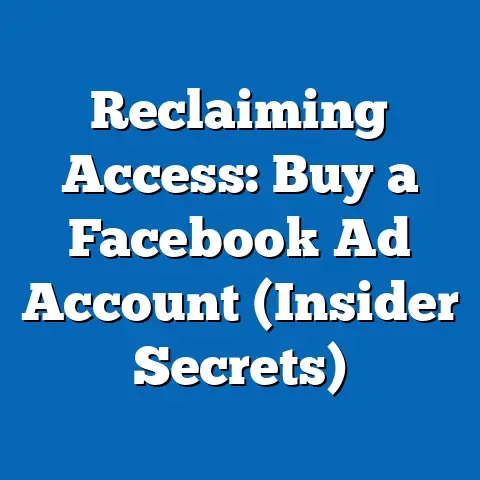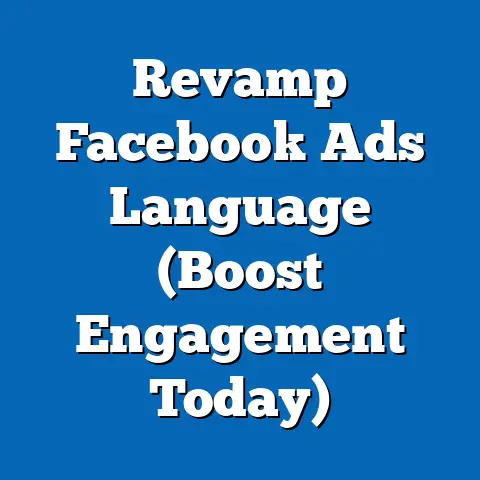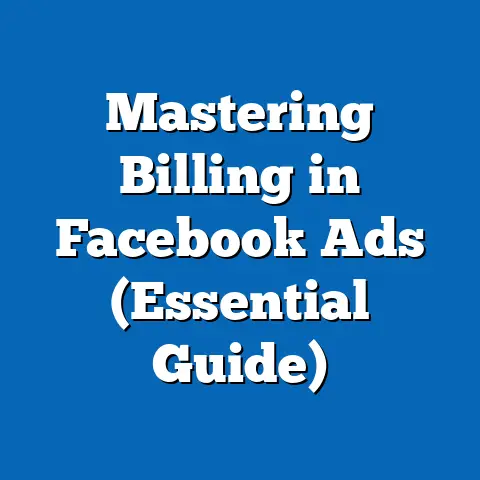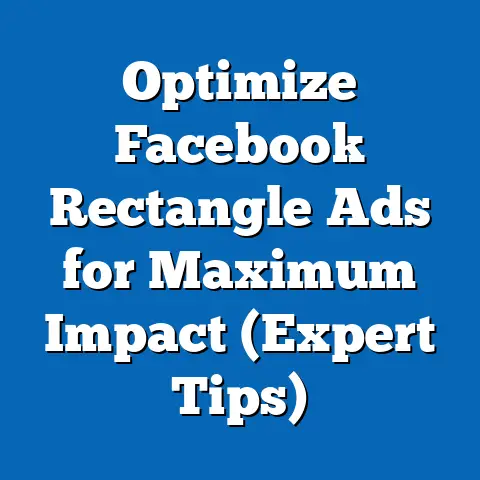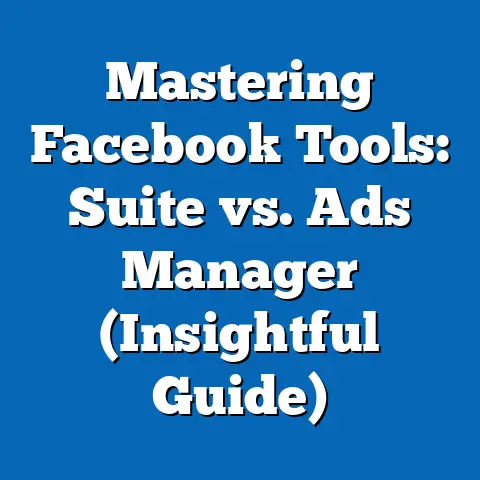Master Crypto Ads on Facebook (Ultimate Guide)
The world of cryptocurrency is no longer a niche corner of the internet. It’s rapidly evolving, reshaping financial landscapes, and, crucially, influencing how we approach digital advertising. I’ve watched this transformation firsthand, from the early days of Bitcoin to the rise of DeFi and NFTs. The increasing acceptance of cryptocurrencies in mainstream finance and commerce presents a huge opportunity for businesses, but capitalizing on this trend requires a strategic approach, particularly on platforms like Facebook.
Mastering Facebook ads specifically for crypto-related products and services is no longer optional; it’s essential to stay ahead in a competitive market. In this guide, I’m going to walk you through everything you need to know, from understanding Facebook’s advertising ecosystem to crafting compelling ad copy and optimizing your campaigns for maximum ROI. Think of this as your roadmap to navigating the often-complex world of crypto advertising on Facebook. Let’s dive in!
Understanding Facebook’s Advertising Ecosystem
Before we even think about crafting the perfect ad, it’s crucial to understand the playing field. Facebook’s advertising ecosystem is vast and powerful, but it also comes with its own set of rules and nuances.
Overview of Facebook Ads
Facebook ads operate on an auction system. Advertisers bid for ad space based on their target audience, budget, and ad relevance. The platform then determines which ads to show based on a combination of factors, including bid amount, ad quality, and estimated action rates.
Targeting options are incredibly granular. You can target users based on demographics (age, gender, location), interests (crypto, blockchain, finance), behaviors (online purchases, app usage), and even custom audiences built from your own customer data.
The ad formats are diverse, ranging from simple image ads and video ads to carousel ads (showcasing multiple products) and lead generation ads (collecting user information directly on Facebook). Understanding these options is the first step in creating effective campaigns.
- Image Ads: Single image with text. Great for visual appeal.
- Video Ads: Engaging, dynamic content. Ideal for tutorials or brand stories.
- Carousel Ads: Showcase multiple products or features.
- Collection Ads: Visually immersive, mobile-first experience.
- Lead Generation Ads: Collect leads directly within Facebook.
Takeaway: Facebook ads are powerful because of their sophisticated targeting and diverse ad formats. Mastering the basics of the auction system is crucial for cost-effective campaigns.
Importance of Compliance
This is where things get tricky, especially in the crypto space. Facebook has strict advertising policies, and they are particularly vigilant when it comes to cryptocurrency. Ads promoting cryptocurrencies, ICOs, or related services are often subject to specific requirements and restrictions.
For example, you might need to obtain written permission from Facebook to run ads promoting certain crypto products. You’ll also need to ensure your ads comply with all applicable laws and regulations in the regions you’re targeting.
I’ve seen countless ads get disapproved simply because they didn’t adhere to these policies. It’s not enough to have a great product and a compelling ad; you need to make sure you’re playing by Facebook’s rules.
- Review Facebook’s Advertising Policies: Familiarize yourself with the specific guidelines for cryptocurrency ads.
- Be Transparent: Clearly disclose any risks associated with investing in cryptocurrency.
- Avoid Misleading Claims: Don’t promise guaranteed returns or make unsubstantiated claims.
- Comply with Regulations: Ensure your ads comply with all applicable laws and regulations.
Takeaway: Compliance is paramount. Ignoring Facebook’s advertising policies can lead to ad disapproval, account suspension, and wasted ad spend.
Identifying Your Target Audience
Who are you trying to reach? This is the most fundamental question in any advertising campaign. In the crypto niche, your target audience could range from seasoned investors to curious beginners.
Start by defining your ideal customer profile. Consider their demographics (age, location, income), interests (cryptocurrency, blockchain, finance, technology), and behaviors (online trading, crypto app usage).
Facebook’s targeting options allow you to narrow down your audience based on these factors. You can also create custom audiences by uploading your existing customer data or creating lookalike audiences based on your existing customer base.
- Demographics: Age, gender, location, education, income.
- Interests: Cryptocurrency, blockchain, finance, technology, investing.
- Behaviors: Online trading, crypto app usage, online purchases.
- Custom Audiences: Upload your customer list or create lookalike audiences.
Takeaway: Understanding your target audience is crucial for effective targeting. Use Facebook’s targeting options to reach the right people with the right message.
Crafting Compelling Ad Copy for Crypto
Once you understand your audience and the rules of the game, it’s time to craft ad copy that resonates. This is where creativity and strategic messaging come into play.
Key Elements of Effective Ad Copy
Effective ad copy is clear, concise, and compelling. It grabs attention, communicates value, and inspires action. Here are the key elements:
- Headline: The first thing people see. Make it attention-grabbing and relevant.
- Description: Provides more detail about your product or service. Highlight the benefits.
- Call to Action (CTA): Tells people what you want them to do. Use action-oriented language.
For example, instead of saying “Learn about Crypto,” try “Unlock Your Crypto Potential: Learn More Now!”
I’ve found that testing different headlines and CTAs is crucial for optimizing ad performance. Experiment with different variations to see what resonates best with your audience.
Addressing Common Objections
Cryptocurrency is still relatively new to many people, and it comes with its own set of perceived risks and concerns. Addressing these objections directly in your ad copy can help build trust and overcome skepticism.
Some common objections include:
- Volatility: The price of cryptocurrencies can fluctuate wildly.
- Security: Concerns about hacking and theft.
- Complexity: The technology can be confusing for beginners.
- Regulation: Uncertainty about the legal and regulatory landscape.
For example, you could address the volatility objection by highlighting the long-term potential of cryptocurrency or by offering strategies for managing risk. You could address the security objection by emphasizing the security measures you have in place to protect your users’ funds.
- Volatility: “Invest in crypto with confidence. Our platform offers risk management tools and expert guidance.”
- Security: “Your security is our top priority. We use industry-leading security measures to protect your funds.”
- Complexity: “Cryptocurrency made easy. Our platform is designed for beginners and experts alike.”
- Regulation: “We comply with all applicable laws and regulations. Your peace of mind is important to us.”
Takeaway: Addressing common objections in your ad copy can help build trust and overcome skepticism. Be transparent and address concerns head-on.
Utilizing Storytelling Techniques
People connect with stories. Instead of just listing the features of your product or service, tell a story that resonates with your audience.
For example, you could tell the story of someone who used your platform to achieve their financial goals. You could tell the story of how your company was founded and why you’re passionate about cryptocurrency.
I’ve found that storytelling can be incredibly powerful for creating emotional connections and driving engagement. It humanizes your brand and makes your message more relatable.
- Example Story: “Meet Sarah. She was tired of working a 9-to-5 job and wanted to take control of her financial future. With our platform, she learned how to invest in cryptocurrency and now earns passive income from her phone.”
Takeaway: Storytelling can create emotional connections and drive engagement. Humanize your brand and make your message more relatable.
Designing Eye-Catching Visuals
In the fast-paced world of social media, visuals are king. Your ad’s visuals are the first thing people see, and they play a crucial role in capturing attention and driving engagement.
Importance of Visuals in Ads
Think of your visuals as the hook that grabs people’s attention as they’re scrolling through their Facebook feed. A compelling visual can stop someone in their tracks and make them want to learn more about your product or service.
Conversely, a poorly designed visual can turn people off and cause them to scroll right past your ad.
- Visuals Capture Attention: They’re the first thing people see.
- Visuals Communicate Value: They can convey your message quickly and effectively.
- Visuals Drive Engagement: They can inspire people to click, like, and share your ad.
Takeaway: Visuals are crucial for capturing attention and driving engagement. Invest time and effort in creating high-quality visuals that resonate with your target audience.
Best Practices for Crypto Ad Design
Creating visuals that resonate with your target audience requires a deep understanding of their preferences and pain points. Here are some best practices:
- Use High-Quality Images: Avoid blurry or pixelated images.
- Choose Relevant Imagery: Use images that are relevant to your product or service.
- Use Eye-Catching Colors: Choose colors that are visually appealing and align with your brand.
- Keep it Simple: Avoid cluttering your visuals with too much text or graphics.
- Showcase Benefits: Highlight the benefits of your product or service in your visuals.
I’ve found that using visuals that show real people using and benefiting from your product or service can be incredibly effective. People are more likely to trust and engage with ads that feel authentic and relatable.
- Color Schemes: Consider using colors associated with trust and security, like blue and green.
- Imagery: Use images of people using crypto in everyday situations or images that evoke feelings of financial freedom and success.
- Branding: Ensure your visuals align with your brand’s overall look and feel.
Takeaway: Creating visuals that resonate with your target audience requires a deep understanding of their preferences and pain points. Use high-quality images, relevant imagery, eye-catching colors, and keep it simple.
A/B Testing Visuals
What works and what doesn’t? The only way to know for sure is to test different visuals and see which ones perform best.
A/B testing involves creating two or more versions of your ad with different visuals and running them simultaneously to see which one generates the best results.
You can test different images, colors, layouts, and even different types of visuals (e.g., image vs. video).
I’ve found that A/B testing is essential for optimizing ad performance. It allows you to make data-driven decisions and continuously improve your ads over time.
- Test Different Images: Try different images that showcase your product or service in different ways.
- Test Different Colors: Experiment with different color schemes to see which ones resonate best with your audience.
- Test Different Layouts: Try different layouts to see which ones are most visually appealing and effective.
- Test Different Types of Visuals: Compare the performance of image ads vs. video ads.
Takeaway: A/B testing visuals is essential for optimizing ad performance. Make data-driven decisions and continuously improve your ads over time.
Setting Up Your Campaign
Now that you have your ad copy and visuals ready, it’s time to set up your campaign in Facebook Ads Manager. This involves choosing the right ad objective, setting your budget and bidding strategy, and selecting your ad placement options.
Choosing the Right Ad Objective
Facebook offers a variety of ad objectives, each designed to achieve a specific goal. Choosing the right ad objective is crucial for maximizing your campaign’s effectiveness.
Some common ad objectives include:
- Awareness: Reach a broad audience and increase brand awareness.
- Traffic: Drive traffic to your website or landing page.
- Engagement: Get more likes, comments, and shares on your ads.
- Leads: Collect leads directly within Facebook.
- App Installs: Drive downloads of your mobile app.
- Conversions: Drive sales or other desired actions on your website.
For example, if your goal is to generate leads for your crypto investment platform, you would choose the “Leads” objective. If your goal is to drive traffic to your website, you would choose the “Traffic” objective.
I’ve found that choosing the right ad objective is essential for aligning your campaign with your business goals. It helps Facebook optimize your ads for the desired outcome.
Takeaway: Choosing the right ad objective is crucial for maximizing your campaign’s effectiveness. Align your ad objective with your business goals.
Budgeting and Bidding Strategies
How much should you spend on your Facebook ads? This is a question that every advertiser struggles with.
There’s no one-size-fits-all answer, as the ideal budget depends on a variety of factors, including your target audience, ad objective, and competition.
However, here are some general guidelines:
- Start Small: Begin with a small budget and gradually increase it as you see results.
- Set a Daily Budget: This allows you to control your spending and avoid overspending.
- Consider Your Target Audience: The larger your target audience, the larger your budget will need to be.
- Experiment with Different Bidding Strategies: Facebook offers a variety of bidding strategies, including automated bidding and manual bidding.
I’ve found that automated bidding strategies can be a good option for beginners, as they allow Facebook to optimize your bids for the best results. However, more experienced advertisers may prefer to use manual bidding to have more control over their bids.
- Automated Bidding: Facebook automatically sets your bids to maximize your results.
- Manual Bidding: You set your bids manually, giving you more control over your spending.
Takeaway: Setting an appropriate budget and bidding strategy is crucial for maximizing ad performance while minimizing costs. Start small, set a daily budget, and experiment with different bidding strategies.
Ad Placement Options
Where do you want your ads to appear on Facebook? Facebook offers a variety of ad placement options, including:
- Facebook Feed: The main news feed on Facebook.
- Instagram Feed: The main news feed on Instagram.
- Facebook Stories: Short-form video content on Facebook.
- Instagram Stories: Short-form video content on Instagram.
- Facebook Marketplace: A platform for buying and selling goods on Facebook.
- Audience Network: A network of third-party websites and apps.
I’ve found that testing different ad placement options is crucial for optimizing ad performance. Some placements may work better for certain ad objectives or target audiences.
- Facebook Feed: Best for reaching a broad audience and driving traffic to your website.
- Instagram Feed: Best for visually appealing ads and reaching a younger audience.
- Facebook Stories: Best for short-form video content and driving engagement.
- Audience Network: Best for reaching a broader audience and driving app installs.
Takeaway: Selecting the right ad placement options is crucial for maximizing your campaign’s reach and engagement. Test different placements and see which ones perform best for your target audience and ad objective.
Measuring Success and Optimizing Campaigns
Once your campaign is up and running, it’s crucial to track your results and optimize your campaign based on the data. This is an ongoing process that requires constant monitoring and adjustment.
Key Metrics to Track
There are a variety of metrics you can track for your Facebook ads, but some of the most important include:
- Impressions: The number of times your ad was shown.
- Reach: The number of unique people who saw your ad.
- Clicks: The number of times people clicked on your ad.
- Click-Through Rate (CTR): The percentage of people who clicked on your ad after seeing it.
- Cost Per Click (CPC): The average cost you paid for each click on your ad.
- Conversions: The number of desired actions that occurred as a result of your ad (e.g., sales, leads).
- Conversion Rate: The percentage of people who completed a desired action after clicking on your ad.
- Return on Ad Spend (ROAS): The amount of revenue you generated for every dollar you spent on ads.
I’ve found that tracking these metrics is essential for understanding how your ads are performing and identifying areas for improvement.
Takeaway: Tracking key metrics is essential for understanding how your ads are performing and identifying areas for improvement.
Using Facebook Analytics
Facebook Analytics provides a wealth of data about your ad performance. You can use this data to gain insights into your audience, your ad copy, your visuals, and your overall campaign performance.
For example, you can use Facebook Analytics to see:
- Which demographics are most likely to click on your ads.
- Which ad copy is generating the most engagement.
- Which visuals are driving the most conversions.
- Which ad placements are performing best.
I’ve found that Facebook Analytics is an invaluable tool for optimizing my campaigns. It allows me to make data-driven decisions and continuously improve my ads over time.
Takeaway: Facebook Analytics provides a wealth of data about your ad performance. Use this data to gain insights into your audience, your ad copy, your visuals, and your overall campaign performance.
Iterative Optimization
Optimization is not a one-time event; it’s an ongoing process. You should be constantly monitoring your results and making adjustments to your campaign based on the data.
For example, you might need to:
- Adjust your targeting to reach a more relevant audience.
- Rewrite your ad copy to make it more compelling.
- Change your visuals to make them more eye-catching.
- Adjust your bidding strategy to maximize your ROI.
I’ve found that iterative optimization is the key to long-term success with Facebook ads. It allows you to continuously improve your campaigns and stay ahead of the competition.
Takeaway: Iterative optimization is the key to long-term success with Facebook ads. Constantly monitor your results and make adjustments to your campaign based on the data.
Conclusion
Mastering Facebook ads for the cryptocurrency niche is an ongoing journey, but it’s a journey that’s well worth taking. As the digital landscape continues to evolve, so too must your advertising strategies. By understanding Facebook’s advertising ecosystem, crafting compelling ad copy, designing eye-catching visuals, setting up your campaign effectively, and measuring your success, you can unlock the potential of Facebook ads as a powerful tool to reach and engage with your target audience in the ever-expanding world of cryptocurrency.
Don’t be afraid to experiment, test new ideas, and continuously learn. The crypto world is dynamic, and your advertising strategies need to be just as adaptable. Now, armed with this guide, go out there and create some winning crypto ads!

